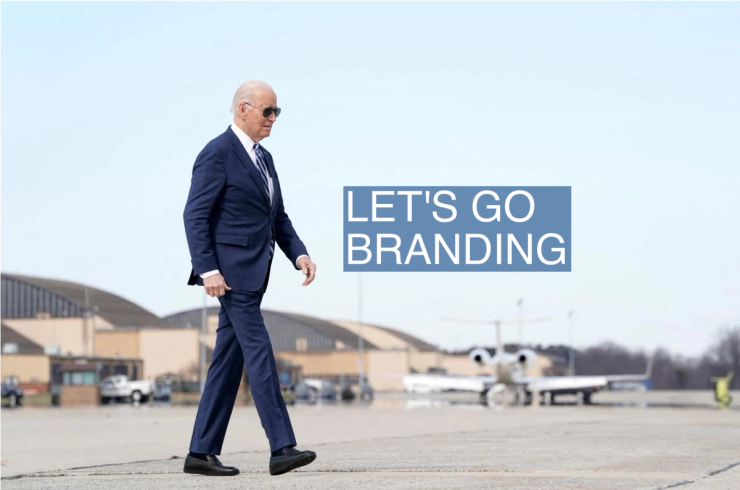The News
There’s President Joe Biden, the man voters might glimpse standing behind a podium or shaking hands with a world leader, and who spends most of his days in private meetings. Then there’s “Joe Biden,” the persona that ad makers and digital strategists construct as part of a billion-dollar campaign.
Every presidential campaign involves building a shorthand version of the candidate that can be captured in a 30-second ad. But deciding how to pitch that “Joe Biden” — which traits to emphasize, which to downplay, and for which audiences — is especially important this cycle, because real-life Biden lacks the same draw on public attention as his predecessors. Even setting aside questions related to his age and ability to campaign aggressively, he’s been a more low-key president: He does relatively few interviews and has a harder time breaking through news cycles with a big speech, as Barack Obama often tried to, or outrageous provocation, Donald Trump’s go-to move.
You’re going to see a lot of that ad version of Biden. Already, team Biden has plenty of money to play with: In the fourth quarter, the campaign reported raising $97 million while holding a historic $117 million cash reserve between the reelection campaign, the DNC, and state parties. Meanwhile, the main Biden Super PAC, Future Forward, has already planned a massive $250 million ad buy across key battleground states for later this year. That number includes $140 million dedicated to TV and $110 million on digital and streaming efforts, The New York Times reported in January.
Rob Flaherty, Biden’s deputy campaign manager, noted that today’s media environment is “very fractured,” meaning that the campaign has had “to go to more places” in order to effectively communicate. The goal is “to make content that accentuates his core qualities,” rather than try to build a Biden that rings false.
“‘Man at podium’ optimized for TV news cameras might not actually be the best format to reach a lot of people. It might be ‘man in living room’ where the content is being produced by the people in the living room,” Flaherty said. “We play to strengths and we play to places where you can see a particular side of the president.”
The official Biden brand has been multifaceted to this point. There’s the earnest patriot, shown warning in one early ad about the threat to American democracy and portrayed in another as a bulwark against threats to democratic allies abroad. There’s “Middle Class Joe,” the Scranton native who is “determined to reward hard work” in another ad by passing laws to build infrastructure and boost manufacturing. Online, his first TIkTok portrays him as Gen Z’s corny grandpa, endorsing “Mama Kelce” over Travis and Jason.
Empathy has played a big part in prior campaigns: His 2020 convention featured a memorable video about him encouraging a child who, like him, suffered from a stutter. Heather Reid, who worked as the DNC’s deputy chief mobilization officer during the 2020 election, said Biden’s last campaign was notable for its emphasis on material that featured him talking to voters in a relaxed setting. His re-elect looks to be deploying the same approach, with an extended video this week that featured him dining with a Black family in North Carolina at their family home.
“The best version of Joe Biden is when he gets the opportunity to just connect with normal people, particularly on a one to one basis, and have normal conversations with real people about their lives and the things that they care about,” she said.
Then there’s “Dark Brandon,” an online-only persona derived from a 2022 meme who shoots lasers out of his eyes and has taken on a massive presence in the campaign’s social media and merchandising. This Biden is portrayed as a merciless destroyer who ruthlessly accomplishes his goals while his base cheers and conservatives cry — a kind of irony-drenched counterpart to Trump’s “own the libs” brand. An in-character tweet mocking right-wing conspiracies around Taylor Swift after the Super Bowl garnered hundreds of millions of impressions.
That extreme version of Biden points to the challenges of this cycle, where the most sought-after marginal voters participate in very different media with very different conventions. The 2020 campaign turned to live-streams on Twitch and campaign yard signs in the game Animal Crossing. The White House has actively courted influencers while the campaign’s TikToks are already aping the POV look and feel associated with the app.
“It’s just never been more valuable to own your own publishing platform that reaches directly to voters with a message you know that they care about,” Tim Hogan, a Democratic consultant, told Semafor. “It is valuable and powerful for them to turn on the camera and show Joe Biden in his element talking about his successes, showing that he’s a strong leader, instead of just relying on other media outlets to go cover a press conference and pick one or two things they want to elevate out of that to be the dominant story. Particularly when that — especially right now — is horse race, and age.”
Of course, any discussion of the Biden brand has to include his age. Depending on how they approach it, he could be a time-tested steady hand, a cranky old man with no patience for MAGA malarkey, or maybe just younger than he looks from the outside. One early campaign ad last year focused on his trip to Ukraine, including the stamina required to enter an active warzone through a transatlantic flight and daylong train ride (hint hint).
How they ultimately address the topic, and whether it comes off as credible, may be the most important decision they make. Jon Stewart, in his return to The Daily Show, skewered Biden’s campaign for turning down a Super Bowl interview that might address age concerns while making a TikTok instead. “Fire everyone,” he said. “How do you go on TikTok and end up looking older?”
Shelby’s view
It’s not crazy to think the Biden campaign prefers to sell Biden via pre-taped TikToks, 30-second ads, and edited sit-downs in an election cycle where age concerns have only grown and the price of a stray gaffe (fairly or not) keeps getting higher.
But Biden’s campaign is also smart to focus on alternative media, especially newer online spaces that can reach beyond cable news audiences. Polls show he’s struggling with younger voters, who are less likely to tune in for a network sitdown or a local TV segment on a speech, which makes building up a clearly recognizable Biden persona that lives where they actually spend their time more crucial.
Still, at the end of the day, paid and digital media can’t fully substitute for the earned media that — in most cycles — is considered among the biggest advantages an incumbent has. Many Biden supporters are already urging him to do more public, unscripted events and interviews to complement the campaign’s work. Philippe Reines, who worked as Hillary Clinton’s advisor, told Politico that Biden should “flood the zone,” adding that the response to gaffes shouldn’t be to “put him out there zero times to prevent zero things.” New York Times columnist Ezra Klein, going the other direction, urged Biden to drop out on Friday, almost entirely based on his perceived inability to manage typical campaign events and media appearances.
Room for Disagreement
Tim Hogan argued that the Biden campaign needed to find ways to bypass the mainstream media, or risk being sucked constantly into an unfair conversation about the president’s competence. “I think the press is focused on the narrative of their choice and the choice is to frame much of the conversation around age,” he said. “When the stakes are this high, they have to find a way to get around that media obsession and that editorial direction from traditional press.”
The View From A Republican
Fred Davis, a veteran Republican ad man, said Biden is no longer an effective on-camera messenger given his shaky appearance and that, if he were handling his candidacy, the focus would be on keeping him out of ads and tapping surrogates to talk about his record for him.
“I actually heard a list of accomplishments the other day that somebody gave — it wasn’t Joe — and it was a pretty impressive list,” Davis said. “You just keep his mug out of it, and certainly keep him talking out of it.”
Notable
- Donald Trump is also taking unique approaches in his effort to target certain voting groups: The former president has hit up sporting events, a college fraternity, and has garnered the support of a number of rappers this election cycle, Semafor reported last December.


